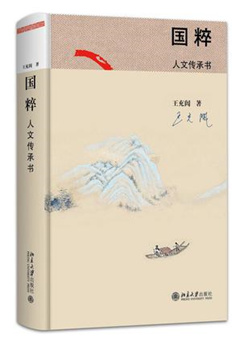
. > WHAT'S NEW > BOOKS
Cultural conventions and preservation
Author : MENG FANHUA Source : Chinese Social Sciences Today 2017-10-24

National Quintessence: Heritage of the Humanities
Author: Wang Chonglü
Publisher: Peking University Press
In the annals of Chinese cultural icons, few modern writers in China can compare with Wang Chonglü. Wang stands out not only because of his erudition, but also because of his understanding and explanation of the “national quintessence.”
In fact, ever since the New Culture Movement in 1919, debates on the “national quintessence” have never ended. Even within the circle of traditional and modern scholars, opinions on such concepts as Confucian and political orthodoxy have diverged. Hence, facing the far more complicated cultural network, it is much harder to identify the “quintessence” of a nation’s culture.
Wang’s cultural awareness first lies in his methodology in historical analysis. He thinks that history is human-oriented. Only when the readers understand the people in history can they grasp the depth of history and have a better understanding of those figures that faced key historical junctions. This opens them up to a kind of “heart-to-heart” conversation with history.
Wang’s book National Quintessence: Heritage of the Humanities is divided into four parts: “Ancestor: lifeblood,” “Humanities: symbol of life,” “Rivers and mountains: civilization landscape” and “Traditions: living wisdom.” The first part introduced various figures including the legend of the “Yellow Emperor,” honored as the first ancestor of all Han Chinese; ancient scholars, such as Confucius, Mozi, Zhuangzi and Mencius; emperors and kings such as the Emperor of Qin and Songtsen Gampo, as well as the Tibetan queen Princess Wencheng; eminent poets such as Li Bai, Su Shi, Zhao Ji (the Hui Emperor of the Song Dynasty) and Nalan Xingde; and important statesmen, such as Qin Liangyu, Yuan Mei and Zeng Guofan.
On the one hand, these figures comprise the general landscape of Chinese history: the Yellow Emperor created the civilization, and the ancient scholars laid the meta-discourse of Chinese culture, which also has been glorified by accomplishments made by empires and masterpieces left by poets and litterateurs. On the other hand, Wang indicated historical narration needs to be a product of humanity, and is a key responsibility.
The chapter “Humanities: symbol of life” includes illustrations of rock paintings in the Helan mountains, the I Ching, the seven sages of the bamboo grove, ancient poems, couplets hung on the columns of halls, family names and seating arrangements. These specific examples contain material objects, literal treasures and ordinary customs and ideas. These cultural symbols are the “root of spirit” for Chinese people, governing their lives and emotions.
The chapter “Rivers and mountains: civilization landscape” elaborated on human geography. This chapter integrates space and time, in which the time is history and the space is existence. The chapter “Traditions: living wisdom” introduced attitudes toward life. It contains daily matters and people, such as the mother of Mencius, regional culture, hermits, love and relationships, hereditary monarchy and imperial examinations. Wang aimed to tell the audience that living customs are stronger than ideology. Ideas are always changing while the customs usually change at a much slower pace.
Ye Shengtao made Chinese fairy tales from a wilderness
Ye Shengtao (1894–1988) created the first collection of fairy tales in the history of Chinese children’s literature...
-
How northern ethnicities integrated into Chinese nation
2023-09-18
-
Mogao caves
2023-09-12
-
Mogao Grottoes as ‘a place of pilgrimage’
2023-09-12
-
Time-honored architectural traditions in China
2023-08-29
-
Disentangling the civilizational evolution of China
2023-08-28
-
AI ethics in science fiction
2023-08-23













 2011-2013 by www.cssn.cn. All Rights Reserved
2011-2013 by www.cssn.cn. All Rights Reserved